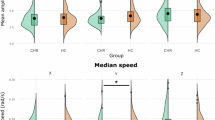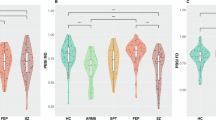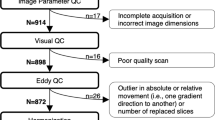Abstract
Impairments in mismatch negativity (MMN) are well-established in schizophrenia and have been observed in youth at clinical high-risk for psychosis (CHR-P). Prior animal studies have shown that social isolation may be related to neurobiological changes, including reduced MMN-like responses and schizophrenia-like behaviors. In parallel, neighborhood social fragmentation has been shown to be associated with the onset of psychosis. This study investigates the association between neighborhood social fragmentation and MMN impairment among CHR-P youth and healthy comparisons (HC). Data were collected from the North American Prodrome Longitudinal Study Phase 2. Electroencephalography was recorded during an unattended auditory oddball paradigm with duration-, pitch-, and double-deviant tones. Generalized linear mixed models tested the association between neighborhood social fragmentation and the frontal-central averaged MMN for three deviant types for youth at CHR-P and HC separately. The models adjusted for age, sex, race/ethnicity, parental education, parental history of psychosis, and neighborhood poverty. Participants (mean [SD] age: 18.69 [4.59], 41.9% females, 51.3% White non-Hispanic) included 304 CHR-P and 92 HC. In the CHR-P group, greater neighborhood social fragmentation was associated with impaired duration-deviant MMN (bootstrapped β = 0.18, 95% CI: 0.04 to 0.33, p = .022) but not for pitch-deviant (bootstrapped β = 0.09, 95% CI: −0.05 to 0.22, p = .199) or double-deviant MMN (bootstrapped β = 0.10, 95% CI: −0.09 to 0.17, p = .559). Greater neighborhood social fragmentation was associated with impaired duration-deviant MMN amplitude among high-risk individuals. Further research is needed to explore underlying mechanisms.
This is a preview of subscription content, access via your institution
Access options
Subscribe to this journal
Receive 13 print issues and online access
$259.00 per year
only $19.92 per issue
Buy this article
- Purchase on SpringerLink
- Instant access to full article PDF
Prices may be subject to local taxes which are calculated during checkout


Similar content being viewed by others
Data availability
All NAPLS-2 data are available upon request from the study authors.
References
Näätänen R, Gaillard AWK, Mäntysalo S. Early selective-attention effect on evoked potential reinterpreted. Acta Psychologica. 1978;42:313–29.
Umbricht D, Krljes S. Mismatch negativity in schizophrenia: a meta-analysis. Schizophr Res. 2005;76:1–23.
Erickson MA, Ruffle A, Gold JM. A Meta-Analysis of Mismatch Negativity in Schizophrenia: From Clinical Risk to Disease Specificity and Progression. Biol Psychiatry. 2016;79:980–7.
Kawakubo Y, Kamio S, Nose T, Iwanami A, Nakagome K, Fukuda M, et al. Phonetic mismatch negativity predicts social skills acquisition in schizophrenia. Psychiatry Res. 2007;152:261–65.
Baldeweg T, Klugman A, Gruzelier J, Hirsch SR. Mismatch negativity potentials and cognitive impairment in schizophrenia. Schizophrenia Res. 2004;69:203–17.
Lee SH, Sung K, Lee KS, Moon E, Kim CG. Mismatch negativity is a stronger indicator of functional outcomes than neurocognition or theory of mind in patients with schizophrenia. Prog Neuropsychopharmacol Biol Psychiatry. 2014;48:213–9.
Light GA, Braff DL. Mismatch negativity deficits are associated with poor functioning in schizophrenia patients. Arch Gen Psychiatry. 2005;62:127–36.
Hamilton HK, Perez VB, Ford JM, Roach BJ, Jaeger J, Mathalon DH. Mismatch Negativity But Not P300 Is Associated With Functional Disability in Schizophrenia. Schizophr Bull. 2018;44:492–504.
Murphy TK, Haigh SM, Coffman BA, Salisbury DF. Mismatch Negativity and Impaired Social Functioning in Long-Term and in First Episode Schizophrenia Spectrum Psychosis. Front Psychiatry. 2020;11:544.
Bodatsch M, Ruhrmann S, Wagner M, Müller R, Schultze-Lutter F, Frommann I, et al. Prediction of Psychosis by Mismatch Negativity. Biol Psychiatry. 2011;69:959–66.
Hamilton HK, Roach BJ, Bachman PM, Belger A, Carrión RE, Duncan E, et al. Mismatch Negativity in Response to Auditory Deviance and Risk for Future Psychosis in Youth at Clinical High Risk for Psychosis. JAMA Psychiatry. 2022;79:780–89.
Perez VB, Woods SW, Roach BJ, Ford JM, McGlashan TH, Srihari VH, et al. Automatic auditory processing deficits in schizophrenia and clinical high-risk patients: forecasting psychosis risk with mismatch negativity. Biol Psychiatry. 2014;75:459–69.
Shaikh M, Valmaggia L, Broome MR, Dutt A, Lappin J, Day F, et al. Reduced mismatch negativity predates the onset of psychosis. Schizophr Res. 2012;134:42–8.
Walker EF, Aberizk K, Yuan E, Bilgrami Z, Ku BS, Guest RM. Developmental perspectives on the origins of psychotic disorders: The need for a transdiagnostic approach. Dev Psychopathol. 2024;36:2559–69.
Ku, Addington J, Bearden CE, Cadenhead KS, Cannon TD, Compton MT, et al. Associations Between Childhood Area-Level Social Fragmentation, Maladaptation to School, and Social Functioning Among Healthy Youth and Those at Clinical High Risk for Psychosis. Schizophrenia Bull. 2023;49:1437–46.
Ku BS, Compton MT, Walker EF, Druss BG. Social Fragmentation and Schizophrenia: A Systematic Review. J Clin Psychiatry. 2021;83:21r13941.
Ku BS, Ren J, Compton MT, Druss BG, Guo S, Walker EF. The association between neighborhood-level social fragmentation and distressing psychotic-like experiences in early adolescence: the moderating role of close friends. Psychological Med. 2024;54:2172–80.
Ku BS, Aberizk K, Feurer C, Yuan Q, Druss BG, Jeste DV, et al. Aspects of Area Deprivation Index in Relation to Hippocampal Volume Among Children. JAMA Network Open. 2024;7:e2416484.
Ku BS, Addington J, Bearden CE, Cadenhead KS, Cannon TD, Compton MT, et al. The associations between area-level residential instability and gray matter volumes from the North American Prodrome Longitudinal Study (NAPLS) consortium. Schizophr Res. 2022:241;1–9.
Aberizk K, Sefik E, Yuan Q, Cao H, Addington JM, Bearden CE, et al.. Relations of temporoparietal connectivity with neighborhood social fragmentation in youth at clinical high-risk for psychosis. Schizophr Res. 2025;277:151–8.
Peter C. Suicide and Parasuicide in London: A Small-area Study. Urban Stud. 1996;33:137–58.
Robert JS. Local Friendship Ties and Community Attachment in Mass Society: A Multilevel Systemic Model. Am Sociological Rev. 1988;53:766.
Bar-Haim Y, Marshall PJ, Fox NA, Schorr EA, Gordon-Salant S. Mismatch negativity in socially withdrawn children. Biol Psychiatry. 2003;54:17–24.
Gunduz-Bruce H, Reinhart RM, Roach BJ, Gueorguieva R, Oliver S, D’Souza DC, et al. Glutamatergic modulation of auditory information processing in the human brain. Biol Psychiatry. 2012;71:969–77.
Rosburg T, Kreitschmann-Andermahr I. The effects of ketamine on the mismatch negativity (MMN) in humans – A meta-analysis. Clin Neurophysiol. 2016;127:1387–94.
Javitt DC, Steinschneider M, Schroeder CE, Arezzo JC. Role of cortical N-methyl-D-aspartate receptors in auditory sensory memory and mismatch negativity generation: implications for schizophrenia. Proc Natl Acad Sci. 1996;93:11962–67.
Javitt DC, Steinschneider M, Schroeder CE, Vaughan HG Jr., Arezzo JC. Detection of stimulus deviance within primate primary auditory cortex: intracortical mechanisms of mismatch negativity (MMN) generation. Brain Res. 1994;667:192–200.
Krystal JH, Anand A, Moghaddam B. Effects of NMDA receptor antagonists: implications for the pathophysiology of schizophrenia. Arch Gen Psychiatry. 2002;59:663–4.
Moghaddam B, Javitt D. From revolution to evolution: the glutamate hypothesis of schizophrenia and its implication for treatment. Neuropsychopharmacology. 2012;37:4–15.
Moghaddam B, Krystal JH. Capturing the angel in “angel dust”: twenty years of translational neuroscience studies of NMDA receptor antagonists in animals and humans. Schizophr Bull. 2012;38:942–9.
Coyle JT, Tsai G, Goff D. Converging evidence of NMDA receptor hypofunction in the pathophysiology of schizophrenia. Ann N Y Acad Sci. 2003;1003:318–27.
Swerdlow NR, Bhakta S, Chou HH, Talledo JA, Balvaneda B, Light GA. Memantine Effects On Sensorimotor Gating and Mismatch Negativity in Patients with Chronic Psychosis. Neuropsychopharmacology. 2016;41:419–30.
Witten L, Oranje B, Mørk A, Steiniger-Brach B, Glenthøj BY, Bastlund JF. Auditory sensory processing deficits in sensory gating and mismatch negativity-like responses in the social isolation rat model of schizophrenia. Behavioural Brain Res. 2014;266:85–93.
Gondora N, Pople CB, Tandon G, Robinson M, Solomon E, Beazely MA, et al. Chronic early-life social isolation affects NMDA and TrkB receptor expression in a sex-specific manner. Neurosci Lett. 2021;760:136016.
Petralia RS. Distribution of extrasynaptic NMDA receptors on neurons. ScientificWorldJournal. 2012;2012:267120.
Addington J, Cadenhead KS, Cornblatt BA, Mathalon DH, McGlashan TH, Perkins DO, et al. North American Prodrome Longitudinal Study (NAPLS 2): overview and recruitment. Schizophr Res. 2012;142:77–82.
Ku, Aberizk K, Addington J, Bearden CE, Cadenhead KS, Cannon TD, et al. The Association Between Neighborhood Poverty and Hippocampal Volume Among Individuals at Clinical High-Risk for Psychosis: The Moderating Role of Social Engagement. Schizophrenia Bull. 2022;48:1032–42.
McGlashan T, Walsh B, Woods S. The psychosis-risk syndrome: handbook for diagnosis and follow-up. Oxford University Press; 2010.
United States Census Bureau. Census Tracts and Block Numbering Areas. 2024. Accessed March 7 2024.
United States Census Bureau. American Community Survey 5-Year Estimates, 2010. U.S. Census Bureau. https://www.census.gov/data/developers/data-sets/acs-5year/2010.html (2010).
Roach BJ, Hamilton HK, Bachman P, Belger A, Carrión RE, Duncan E, et al. Stability of mismatch negativity event-related potentials in a multisite study. Int J Methods Psychiatr Res. 2020;29:e1819.
Gratton G, Coles MG, Donchin E. A new method for off-line removal of ocular artifact. Electroencephalogr Clin Neurophysiol. 1983;55:468–84.
Nolan H, Whelan R, Reilly RB. FASTER: Fully Automated Statistical Thresholding for EEG artifact Rejection. J Neurosci Methods. 2010;192:152–62.
Rahne T, von Specht H, Mühler R. Sorted averaging-application to auditory event-related responses. J Neurosci Methods. 2008;172:74–8.
Duncan CC, Barry RJ, Connolly JF, Fischer C, Michie PT, Näätänen R, et al. Event-related potentials in clinical research: guidelines for eliciting, recording, and quantifying mismatch negativity, P300, and N400. Clin Neurophysiol. 2009;120:1883–908.
Fryer SL, Roach BJ, Hamilton HK, Bachman P, Belger A, Carrión RE, et al. Deficits in auditory predictive coding in individuals with the psychosis risk syndrome: Prediction of conversion to psychosis. J Abnorm Psychol. 2020;129:599–611.
Hamilton HK, Roach BJ, Bachman PM, Belger A, Carrion RE, Duncan E, et al. Association between P300 responses to auditory oddball stimuli and clinical outcomes in the psychosis risk syndrome. JAMA psychiatry. 2019;76:1187–97.
Pentz AB, Timpe CMF, Normann EM, Slapø NB, Melle I, Lagerberg TV, et al. Mismatch negativity in schizophrenia spectrum and bipolar disorders: Group and sex differences and associations with symptom severity. Schizophrenia Res. 2023;261:80–93.
Varchmin L, Montag C, Treusch Y, Kaminski J, Heinz A. Traumatic Events, Social Adversity and Discrimination as Risk Factors for Psychosis - An Umbrella Review. Front Psychiatry. 2021;12:665957.
Lu Y, Pouget JG, Andreassen OA, Djurovic S, Esko T, Hultman CM, et al. Genetic risk scores and family history as predictors of schizophrenia in Nordic registers. Psychological Med. 2018;48:1201–08.
O’Donoghue B, Roche E, Lane A. Neighbourhood level social deprivation and the risk of psychotic disorders: a systematic review. Soc psychiatry Psychiatr Epidemiol. 2016;51:941–50.
Umbricht D, Koller R, Schmid L, Skrabo A, Grübel C, Huber T, et al. How specific are deficits in mismatch negativity generation to schizophrenia? Biol Psychiatry. 2003;53:1120–31.
le Sommer J, Low A-M, Møllegaard Jepsen JR, Fagerlund B, Vangkilde S, Habekost T, et al. Effects of methylphenidate on mismatch negativity and P3a amplitude of initially psychostimulant-naïve, adult ADHD patients. Psychological Med. 2023;53:957–65.
Lee M, Balla A, Sershen H, Sehatpour P, Lakatos P, Javitt DC. Rodent Mismatch Negativity/theta Neuro-Oscillatory Response as a Translational Neurophysiological Biomarker for N-Methyl-D-Aspartate Receptor-Based New Treatment Development in Schizophrenia. Neuropsychopharmacology. 2018;43:571–82.
Novick AM, Mears M, Forster GL, Lei Y, Tejani-Butt SM, Watt MJ. Adolescent social defeat alters N-methyl-D-aspartic acid receptor expression and impairs fear learning in adulthood. Behav Brain Res. 2016;304:51–9.
Usui K, Kirihara K, Araki T, Tada M, Koshiyama D, Fujioka M, et al. Longitudinal change in mismatch negativity (MMN) but not in gamma-band auditory steady-state response (ASSR) is associated with psychological difficulties in adolescence. Cereb Cortex. 2023;33:11070–79.
Xiong Y-B, Bo Q-J, Wang C-M, Tian Q, Liu Y, Wang C-Y. Differential of frequency and duration mismatch negativity and theta power deficits in first-episode and chronic schizophrenia. Front Behav Neurosci. 2019;13:37.
Salisbury DF, Kuroki N, Kasai K, Shenton ME, McCarley RW. Progressive and Interrelated Functional and Structural Evidence of Post-Onset Brain Reduction in Schizophrenia. Arch Gen Psychiatry. 2007;64:521–29.
Todd J, Michie PT, Schall U, Karayanidis F, Yabe H, Näätänen R. Deviant matters: duration, frequency, and intensity deviants reveal different patterns of mismatch negativity reduction in early and late schizophrenia. Biol Psychiatry. 2008;63:58–64.
Aeberli T, Müller M, Theodoridou A, Hagenmuller F, Seifritz E, Walitza S, et al. Mismatch negativity generation in subjects at risk for psychosis: source analysis is more sensitive than surface electrodes in risk prediction. Front Psychiatry. 2023;14:1130809.
Koshiyama D, Kirihara K, Tada M, Nagai T, Koike S, Suga M, et al. Duration and frequency mismatch negativity shows no progressive reduction in early stages of psychosis. Schizophrenia Res. 2017;190:32–38.
Haigh SM, Coffman BA, Salisbury DF. Mismatch negativity in first-episode schizophrenia: a meta-analysis. Clin EEG Neurosci. 2017;48:3–10.
Bhat A, Irizar H, Thygesen JH, Kuchenbaecker K, Pain O, Adams RA, et al. Transcriptome-wide association study reveals two genes that influence mismatch negativity. Cell Rep. 2021;34:108868.
Funding
This work was supported in part by the National Institute of Mental Health (NIMH) grants U01 MH081902 to TDC, P50 MH066286 to CEB, U01 MH081857 to BAC, U01 MH82022 to SWW, U01 MH066134 to JA, U01 MH081944 to KSC, R01 U01 MH066069 to DOP, R01 MH076989 to DHM, U01 MH081988 to EW, and K23 MH129684 to BSK. ED, HH, DHM, GAL, and MAN are employees of the US government. The content is solely the responsibility of the authors and does not necessarily reflect the position or policy of the National Institutes of Health, the Department of Veterans Affairs, or the US government.
Author information
Authors and Affiliations
Contributions
The authors confirm their contributions to the paper as follows: Study Conception and Design: BK, HH, QY, EW, DM; Data Collection: BK, HH, QY, DP, BR, PB, AB, RC, ED, JJ, GL, MN, JA, CB, KC, TC, MK, DP, WS, SW, EW, DM; Analysis and Interpretation of Results: BK, HH, QY, CB, EW, DM; Drafting of the Original Manuscript: BK, HH, QY; Critical Revision for Important Intellectual Content: BK, HH, QY, DP, BR, PB, AB, RC, ED, JJ, GL, MN, JA, CB, KC, TC, MK, DP, WS, SW, EW, DM. All authors reviewed the results, approved the final version of the manuscript, and agreed to be accountable for all aspects of the work in ensuring that questions related to the accuracy or integrity of any part of the work are appropriately investigated and resolved.
Corresponding author
Ethics declarations
Competing interests
TDC has served as a consultant for Boehringer-Ingelheim Pharmaceuticals and Lundbeck A/S. DOP has served as a consultant for Sunovion and Alkermes, has received research support from Boehringer-Ingelheim, and has received royalties from American Psychiatric Association Publishing. SWW has received investigator-initiated research support from Pfizer and sponsor-initiated research support from Auspex and Teva; he has served as a consultant for Biomedisyn (unpaid), Boehringer-Ingelheim, and Merck and as an unpaid consultant to DSM-5; he has been granted a patent for a method of treating prodromal schizophrenia with glycine; and he has received royalties from Oxford University Press. ED has received research support for work unrelated to this project from Posit Science Inc, Auspex Pharmaceuticals, Teva Pharmaceuticals, and GrayMatters Health. The other authors report no financial relationships with commercial interests.
Additional information
Publisher’s note Springer Nature remains neutral with regard to jurisdictional claims in published maps and institutional affiliations.
Supplementary information
Rights and permissions
Springer Nature or its licensor (e.g. a society or other partner) holds exclusive rights to this article under a publishing agreement with the author(s) or other rightsholder(s); author self-archiving of the accepted manuscript version of this article is solely governed by the terms of such publishing agreement and applicable law.
About this article
Cite this article
Ku, B.S., Hamilton, H., Yuan, Q. et al. Neighborhood social fragmentation in relation to impaired mismatch negativity among youth at clinical high risk for psychosis and healthy comparisons. Neuropsychopharmacol. 50, 1446–1454 (2025). https://doi.org/10.1038/s41386-025-02093-4
Received:
Revised:
Accepted:
Published:
Issue date:
DOI: https://doi.org/10.1038/s41386-025-02093-4
This article is cited by
-
Social environment as a determinant of mismatch negativity in early psychosis
Neuropsychopharmacology (2025)



